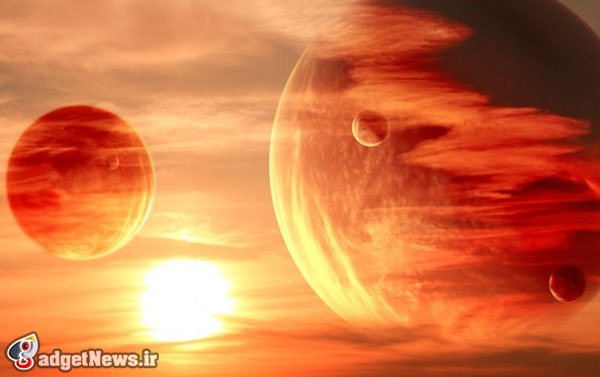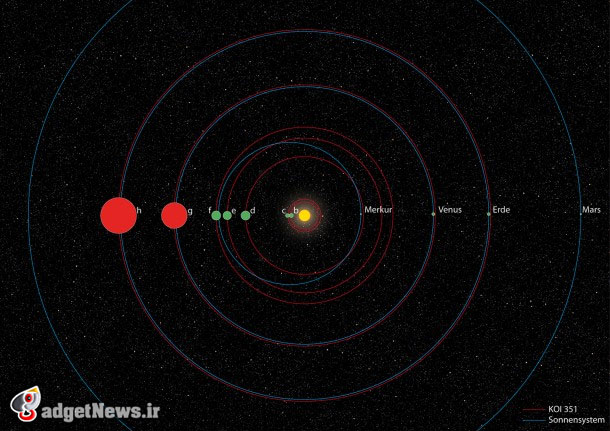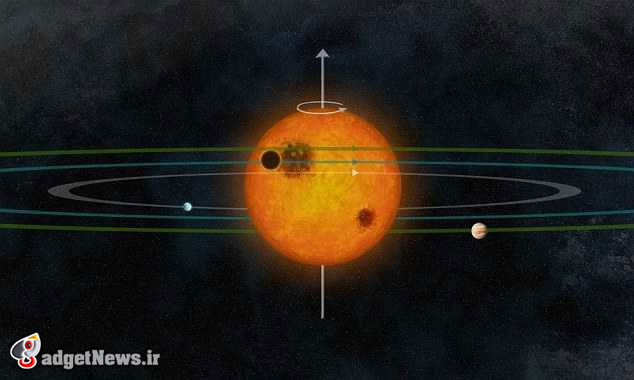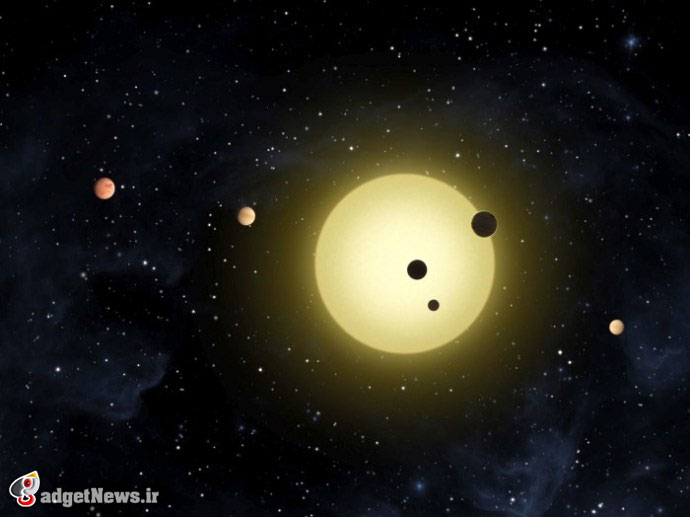
دانشمندان و منجمان اروپایی دومين منظومه خورشيدي و شبیه ترین آنها ، به منظومه شمسی را کشف کردند. منظومه Koi-351 هفت سياره دارد که سیارات خاکی آن نزدیک به ستارهی مادر و سیارات غولپيكر گازی در فاصلهاي دورتر از آن در حال چرخش میباشند.

مقایسه ی منظومه خورشیدی ما و منظومه KOI-351
«جان كاربررا» از مؤسسه تحقيقاتي علوم سيارهاي در مركز علوم هوا فضاي آلمان(DLR )، اين منظومه را نخستين همزاد منظومه شمسی اعلام كرد. طبق آخرين اطلاعات ثبت شده توسط تلسكوپ فضايي كپلر، سه سياره از اين منظومه هفتتايي در اوايل سال جاري كشف شده بودند. دوره گردش اين سيارات در مقایسه با منظومه شمسی متفاوت است و بالاترين تغييرات كشف شده در دوره گردش سيارات فراخورشيدي محسوب ميشود. در مدارهای داخلی این منظومه سیاراتی به بزرگی زمین در حال چرخش اند و در مدارهای خارجی هم سیاراتی بزرگتر مانند مشتری یا زحل می چرخند. این فیزیک اخترشناس میگوید: «ما نمیتوانیم بگوییم اهمیت این کشف تا چه اندازه است. این قدمی بزرگ در جستجو برای پیدا کردن همسان دوقلوی منظومه خورشیدی و زمین دوم است.»

منظومه تازه کشف شده ۲۵۰۰ سال نوری با زمین فاصله دارد. سه سیاره این منظومه در دورههای ۳۳۱، ۲۱۱ و ۶۰ روزه بهدور ستاره مادر میچرخند که به دورههای چرخشی زمین، ناهید و عطارد شباهت دارد. این سه سیاره در سالهای گذشته کشف شدهاند. 4 سیاره دیگری که توسط کابررا و تیم او کشف شدهاند در دورههای ۷، ۹، ۹۲ و ۱۲۵ روزه به دور ستاره خود در چرخشاند. دورترین سیارات این منظومه از ستاره میزبان فاصلهای ۱۵۰ میلیون کیلومتری دارند که به فاصله بین زمین و خورشید شباهت دارد.

تاکنون بیش از 771 سیاره كشف شده كه حداقل ميزبان يك ستاره هستند. با اين حال فقط 170 تاي آنها بيش از يك ستاره را ميزباني كرده اند. منظومه هایی که از تعداد بيشتري سياره تشكيل شده اند استثنا محسوب مي شوند. محققان تعداد آنها را زياد تخمين مي زنند؛ اما مي گويند كشف آنها بسيار سخت میباشد. با اينكه يكي از سيارات اين منظومه بسيار شبيه زمين است، با اين حال نمي توان به آساني گفت كه آيا اين سياره واقعا زمين دوم محسوب مي شود يا نه؟ البته نمیتوان به راحتی پرواز کرد و دید که این زمین دوم چه شکلی است؛ چون برای این کار باید دست کم ۲۵۰۰ سال نوری را پیمود!
منبع : dailygalaxy
New Star System Similar to Ours –“We Cannot Stress Just How Important This Discovery Is"
A team of European astrophysicists has discovered the most extensive planetary system to date that orbit star KOI-351 – with seven planets, more than in other known planetary systems arranged in a similar fashion to the eight planets in the Solar System, with small rocky planets close to the parent star and gas giant planets at greater distances. Although the planetary system around KOI-351 is packed together more tightly, “We cannot stress just how important this discovery is. It is a big step in the search for a ‘twin’ to the Solar System, and thus also in finding a second Earth,” said Juan Cabrera, an astrophysicist at the DLR Institute of Planetary Research in Berlin-Adlershof.
KOI is the abbreviation for ‘Kepler Object of Interest’, which means the star was observed by NASA’s Kepler space telescope, between 2008 and 2013, and classified as a candidate for the existence of exoplanets. At present, KOI-351 is the star with the most extrasolar planets, or exoplanets for short. The star is 2500 light years away from Earth.
Astrophysicists around the world have been searching for a star system similar to our own for a long time. Now, the team led by Cabrera has taken a major step in this direction. Three of the seven planets in orbit around the star KOI-351 were discovered in recent years, and have periods of 331, 211 and 60 days, similar to those of Earth, Venus and Mercury.
The planets discovered by Cabrera and his team are even closer to the star and have orbital periods of 7, 9, 92 and 125 days. The outermost planet orbits the star at a distance of about 150 million kilometres, or roughly one Astronomical Unit (AU), so the entire planetary system is compressed into a space corresponding to the distance between Earth and the Sun.
“No other planetary system shows such a similar ‘architecture’ to that of our cosmic home as does the planetary system around KOI-351,” says Cabrera. “Just as in the Solar System, rocky planets with roughly the size of Earth are found close to the star, while, ‘gas giants’ similar to Jupiter and Saturn are found as you move away from the star.”
The development of a special computer algorithm enabled Cabrera and his team to detect the four new planets around KOI-351 by filtering out the light curves that reveal the ‘transit’ of a planet across its parent star from the Kepler measurements. The discovery was confirmed shortly afterwards by a US group led by Joseph R. Schmitt of Yale University, by visual inspection of the light curves recorded by Kepler.
“The resonances of the planetary orbits are another interesting feature of this system,” explains Szilárd Csizmadia, a member of the team. Resonance occurs when two or more orbiting bodies exert a regular, periodic gravitational influence on one another. “Resonances also play an important role in the Solar System; for example, the moons of Jupiter. So KOI-351 is a gold mine for all researchers investigating planetary formation and the stability of multi-body systems.”
The resonances in the planetary system of KOI-351, however, greatly complicated the search for the planets. Due to the strong interaction between the planets, the signals sought in the Kepler data were not strictly periodic, but showed strong variations in the orbital periods.
“The orbital period of planet KOI-351g varies by about a day between consecutive transits during the observations, said Rudolf Dvorak of the University of Vienna. "Disturbances of this kind have been noted previously, but so far only with maximum deviations of a few minutes.”
After the two successful space telescopes CoRoT and Kepler were decommissioned this year, planet hunters are now hopeful with regard to the pending decision on the PLATO mission. PLATO (Planetary Transits and Oscillations of Stars) will build on the experience of CoRoT and Kepler in the search for planetary systems around nearby bright stars, and thus allow for extensive follow-up observations. This could allow the determination of the radius (as in the system KOI-351) and the mass of the planets, as well as a first look at the composition of the planet.
Furthermore, it would even be possible to examine the atmosphere of the planets in such systems, which may give rise to indications of the activity of living organisms. This would be a major breakthrough in search for a ’second Earth’. The European Space Agency will make a decision on the PLATO mission in early 2014.
Until now, 771 stars with planets have been identified. However, most of the exoplanets discovered so far are ’solitary’. Only 170 stars are known to be orbited by more than one planet. Large planetary systems are the exception – not because they do not exist, but because they are particularly difficult to detect and characterise.
At present, only a handful of systems with at least five planets have been confirmed, including planets KOI-351b and 351c were confirmed. They are only 31 percent and 19 percent larger than the Earth. To detect such small planets, a special algorithm was developed by Cabrera. Besides the size of these planets, what is remarkable is the 5:4 orbital resonance. In the time it takes planet b to complete five orbits, planet c has completes exactly four orbits. Similar resonances are found among the inner moons of Jupiter.
Planet KOI- 351d was already known. It has an orbital period of 60 days. Its diameter is 2.9 times that of Earth’s. It is therefore likely a ’super-Earth’ or a ‘mini-Neptune’. Since the mass is not known, it is not yet possible to classify this planet.
The planet KOI-351e is also a new discovery and is roughly the same size as KOI- 351d (2.9 times the diameter of Earth). We know that neighbouring planets in planetary systems have similar sizes, as we see in the Solar System (Neptune and Uranus, or Venus and Earth). This has now been observed for the first time in exoplanets, and underlines the similarity of this system to our own.
The large gas giants KOI-351g and 351h (about 8 and 11 times the diameter of Earth) are outer planets and have long orbital periods (211 and 331 days). This is very reminiscent of the Solar System, where there also four rocky planets (Mercury, Venus, Earth, Mars) and two gas giants (Jupiter and Saturn ) with diameters 10 and 8 times that of Earth.
The Daily Galaxy via In the Astrophysical Journal, DLR Institute of Planetary Research in Berlin-Adlershof and the German Aerospace Center (Deutsches Zentrum für Luft und- Raumfahrt; DLR).
 گجت نیوز آخرین اخبار تکنولوژی، علم و خودرو
گجت نیوز آخرین اخبار تکنولوژی، علم و خودرو 





